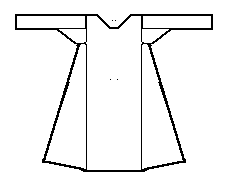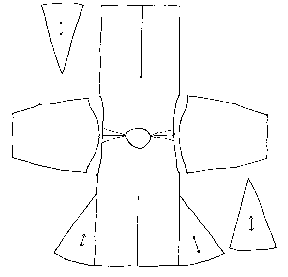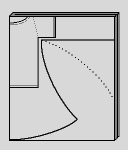Tunic
A type of Garb
Description;
The tunic is "standard" torso garb. It will almost always have sleeves and closed sides, unlike a Tabard which has open sides.
Tunics are sometimes called a 'Bell Tunics'. The 'Bell' refers to the belled shape of the bottom of the Tunic, This is created using triangle shaped gores or cutting the body of the Tunic with sides that slope outward. The garment it's self is pattered on a very large T-shirt.
Historical Finds
The garments of the fifth-century jarl buried at Evebø, Norway, are too fragmentary to determine the way they were made. The remains are mainly useful for what they reveal about tunic length, decoration, and layering. The two wool garments were found in situ with one worn over the other. The red undertunic had elaborate tablet-woven wool trim at the neck, wrists, and hem, with bronze wrist clasps; it came down as far as the knee. The overtunic had a different type of tablet-woven wool trim at the neck, plus silver clasps in some undetermined location (Magnus 1982, 68-69). Given the existence of the silver clasps, as well as the striking appearance of the undertunic, the overgarment may well have been some sort of a coat designed to augment, rather than cover, the undertunic; the clasps might have held it together on the chest.
The excavations at Birka, Sweden, which cover the ninth and tenth centuries, did not include entire garments. However, the pieces of clothing that were found there yielded quite a bit of information on different types of tunic-type garments, including smocks, tunics, and coats. There is plenty of evidence for linen smocks, wool tunics, wool and linen coats, and even one possibly Byzantine-style linen long tunic. Construction details common to them all include front and back panels cut in one piece, rather than two-piece construction with shoulder seams, and small round or keyhole necklines. Triangular gores were added for additional width in the skirt area of many garments. Unique to Birka is evidence for the woman's pleated smock from the tenth century; this style of undergarment would not have required gores for widening. Also unique to Birka is the men's sleeved "riding" coat closed on the chest with small cast bronze buttons running from neck to waist; it is thought to be influenced by Persian riding coats by way of Byzantium and the Rus lands. Some Birka women wore a similar overgarment, but instead of bronze buttons this coat was held together by a fancy brooch pinned through two small loops that were sewn to the two sides of the garment at the mid-chest. It is not known how long the women's coats were, but clearly if they were meant to be protective overgarments they would need to be rather long--and require more than one closure point in front!
Here below are suggested composite styles for a Birka tunic and coat. Note especially the dotted fold lines at the shoulders of both garments and the choice of two necklines offered on the drawing of the tunic garment.
Some Construction Tips
(On historical tunics of the viking style)
Decide how each element of the tunic should be constructed before cutting out anything; then, if need be, make patterns out of paper for each piece that you will need. If you do make paper patterns, be careful to label each pattern piece with the name of the intended wearer of the tunic, the name of the pattern piece (e.g., "sleeve"), and the date. That way you will have a record of how you made the tunic; then you can repeat it if the tunic happens to come out perfect, or adjust the pattern pieces if the tunic isn't perfect.
The front and back panels of a tunic work fairly well if they are as wide as the measurement between the points of the shoulders, plus seam allowances on both sides. Gores can be as narrow or as wide as you like, but if they are too wide they will hang in deep folds rather than draping gracefully.
It is almost impossible to reconstruct the sleeve length and overall length of Viking garments from the pieces that remain. Since sleeves were designed to be close-fitting at the lower end, it is likely that they were wrist-length. Iconographic evidence suggests that tunics were worn at least to mid-thigh, probably down as far as the knee. Jackets seem to have been on the short side, while Birka riding coats were probably longer than the garments they were worn over, perhaps even calf-length. Women's gowns might in some cases have extended only to the lower calf or, as depicted in some figurines, drag behind with a miniature train effect, depending on what sort of work may have needed to be performed while wearing them. Ankle-length gowns and smocks suit the climate and activity level of Pennsic very well, while the train effect is very attractive in a Court setting.
Evidence for Viking garments frequently includes linings; in particular, the coat garment was often lined with silk or linen. Necklines were generally not faced, but enclosed by or edged with durable or decorative trimmings. This effect can be achieved in a variety of ways--by the use of bias tape, purchased trim, braided wool yarn, tablet-weaving, or silk edgings cut out of larger pieces of fabric.
How to
T- Tunic from Fransis
First, obtain your material. Most t-tunics go to just above the knees, but they can also go right to the floor. The length of the cloth should be just a bit more than twice the distance from your shoulder to where you want it to hang to. The width (ideally) will be at least the distance between your wrists when your arms are held out to your sides. Pick a material that's easy to work with. Wool is easiest to work with, since you don't have to treat the edges to keep it from fraying too badly. An old army blanket in olive drab or deep red (not orange!) is ideal. A grey blanket can be left as-is or dyed blue.
Alternatively, you can use broadcloth or whatever you find in the remnants bin. Strong, primary colours are best, with browns and tans less usual. The concept of "matching" was unheard of in the early Middle Ages, and it was common to wear red with green and yellow.
Second, fold the cloth in quarters, raw edges together first and selvedges together second. Note the corner that corresponds with the centre of the fabric.
Third, take a loose fitting sweatshirt or tee-shirt and fold it in half, lengthwise. Lay it on the folded fabric with the lengthwise folds together and the neck at the corner that corresponds with the centre of the cloth.
Mark the outline of the t-tunic using your shirt as a guide. Leave an inch or more for seam allowance and to allow a bit of looseness in the fit. Extend the sleeve line out to the edge of the fabric. Choose either a close fitting sleeve (solid line) or a wide, hanging sleeve (dashed line, usually for women). Extend the sides into a skirt and mark the bottom in an arc.
Fourth, take your shirt off the cloth and cut where you've marked.
Fifth, make the neck hole. Be careful! Most people don't know how tiny their neck really is... measure the thing, first.
Open the cloth out by one fold and make a "D" shape centered on the fold and as big as your neck. Your neck sort-of grows out of the front of your chest, not straight up between your shoulders. The neck hole must reflect this or your garb will ride against the front of your neck and be uncomfortable.
Flip the cloth over and mark a MUCH shallower "D" on the back. Cut this out.
To get it over your head, you need a hole bigger than your neck. Cut a slit down the front of the tunic from the neck hole just far enough so that you can get your head through. Cut this by degrees until it's just right. Since this makes the neck look a bit like a keyhole, it's called a keyhole neck.

Bell Tunic

